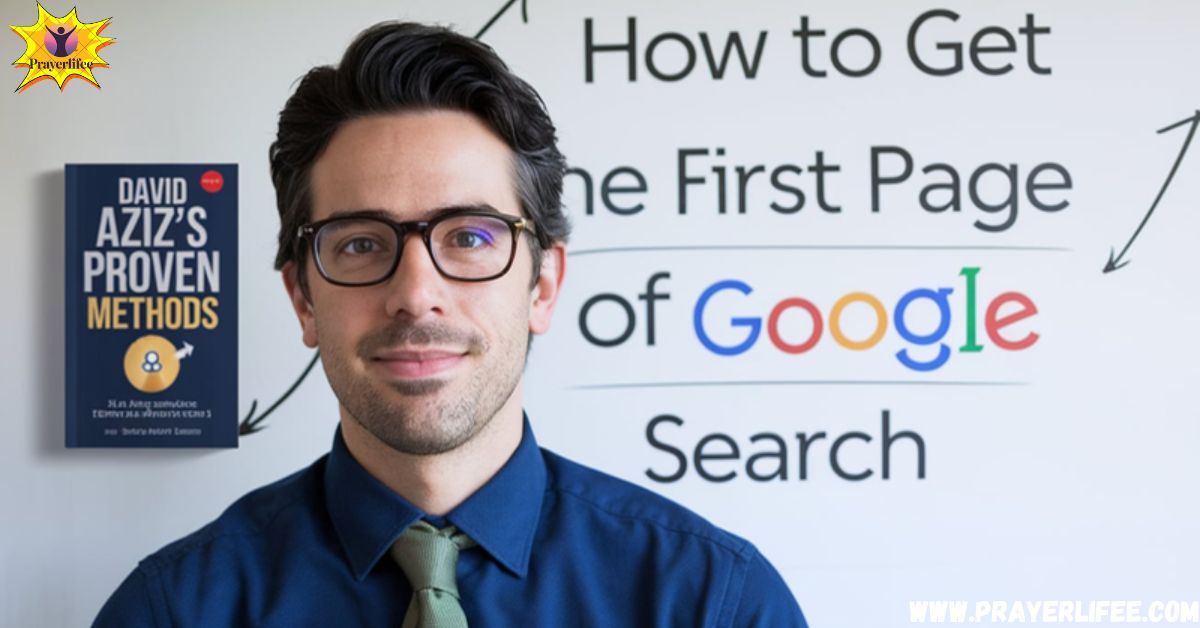Achieving a spot on the first page of Google search results is a goal for many website owners and content creators. With Google being the most widely used search engine, ranking on its first page can make a significant difference in your website’s visibility and traffic. However, ranking high on Google is no easy feat, and it requires consistent effort, technical skills, and a solid understanding of search engine optimization (SEO).
David Aziz, a well-known figure in the digital marketing world, has developed effective strategies that have helped websites achieve and maintain a spot on Google’s first page. This article will explore his approach to SEO, focusing on SEO strategies, keyword targeting, and content optimization, among other techniques, that can help your website rank higher and increase organic search traffic.
Who is David Aziz and Why Learn from His Methods?

David Aziz is a seasoned digital marketing expert known for his innovative and practical approach to search engine optimization. Over the years, he has helped numerous businesses improve their online presence, resulting in higher Google rankings and increased visibility.
His methods focus on blending traditional SEO techniques with modern strategies that align with Google’s ever-evolving algorithm. Learning from David Aziz’s SEO techniques gives you valuable insights into how search engine rankings work, and how to use SEO best practices to stay ahead of the competition.
Core Elements of First-Page Ranking Success
Achieving a spot on the first page of Google’s search engine results pages (SERPs) is no easy task. It requires focusing on a combination of factors, from content optimization to technical SEO.
David Aziz emphasizes that successful first-page ranking depends on several core elements, including high-quality content, proper use of keywords, mobile optimization, and technical optimization. By understanding these key factors, you can develop a comprehensive strategy that improves your website’s SEO performance.
Understanding Google’s Algorithm Updates
Google’s search algorithm is constantly evolving. With more than 500 updates each year, staying updated on Google’s algorithm changes is crucial for maintaining or improving your rankings. Major updates like the Helpful Content Update and the Experience Update have shifted Google’s focus toward improving user experience.
These updates stress the importance of content authority, expertise, and trustworthiness (E-A-T), as well as faster website performance. Google rankings today are more dependent on content quality and user engagement than ever before.
Keyword Research and Implementation
Effective keyword research is the foundation of any successful SEO strategy. Understanding which keywords people are searching for in your niche will help you target the right audience. The key is to identify keywords with high search volume but relatively low competition.
Tools like Google Keyword Planner, Ahrefs, and SEMrush can help you find these valuable keywords. Once you’ve selected your target keywords, you should implement them throughout your content, including in headings, meta descriptions, and URLs. It’s important to use keywords naturally to avoid keyword stuffing, which can harm your rankings.
Long-tail Keyword Strategy
Long-tail keywords are more specific phrases that tend to have lower search volume but higher conversion rates because they closely match a user’s search intent. For example, instead of targeting a broad term like “SEO,” targeting a more specific phrase like “how to improve Google ranking for small businesses” is often more effective.
David Aziz’s approach includes focusing on long-tail keywords, which are generally less competitive and easier to rank for. These types of keywords also attract a more targeted audience, increasing your chances of converting visitors into customers.
Content Quality and Depth
Google prioritizes content that demonstrates expertise, authority, and trustworthiness—E-A-T. High-quality content that provides value to readers will help you rank higher on Google. According to David Aziz’s methods, the content must be comprehensive, answering all potential questions related to the topic.
Articles should be thorough, usually 1,500+ words, and updated regularly to maintain freshness. Using data-driven insights, statistics, and citing reputable sources can further enhance the authority of your content. Multimedia elements such as images, videos, and infographics can make your content more engaging and improve user experience, which in turn can boost your rankings.
Read More: Understanding the Augusta Precious Metals Lawsuit: What Investors Need to Know
Technical SEO Fundamentals

Technical SEO focuses on the behind-the-scenes elements of your website that affect its performance in search engines. This includes optimizing your website’s architecture, improving page speed, ensuring mobile-friendliness, and making sure search engines can easily crawl and index your site.
David Aziz stresses that technical SEO is just as important as content when it comes to improving Google rankings. A website that performs well in all of these areas is more likely to rank higher in SERPs.
Site Speed Optimization
Page speed is a critical ranking factor for Google. Websites that load slowly tend to have higher bounce rates, which negatively impacts rankings. David Aziz’s SEO techniques focus heavily on improving site speed by compressing images, using browser caching, minimizing CSS and JavaScript files, and utilizing a content delivery network (CDN).
Research shows that websites that load in under 2.5 seconds have significantly better chances of ranking on Google’s first page. Using tools like Google PageSpeed Insights can help you identify performance bottlenecks.
Mobile Optimization
With mobile-first indexing, Google now ranks websites based on their mobile versions. This means that if your website is not optimized for mobile devices, it could negatively affect your rankings. David Aziz’s approach emphasizes the importance of responsive design, ensuring that your website adapts to various screen sizes and offers a seamless mobile experience. Tools like Google’s Mobile-Friendly Test can help you assess your site’s mobile usability and identify areas for improvement.
Technical Structure and Navigation
The structure and navigation of your website play a significant role in SEO. Google needs to be able to crawl and understand your site easily, so having a well-organized site structure is essential. David Aziz suggests using clear hierarchy, internal linking, and XML sitemaps to help search engines navigate your site more effectively. Schema markup is another powerful tool that can enhance your visibility in search results by providing additional context to Google about your content.
Building Authority Through Backlinks
Backlinks are one of the most important ranking factors for Google. David Aziz’s SEO strategies emphasize building quality backlinks from authoritative sources within your niche. This helps establish your website’s domain authority and credibility, which can significantly improve your rankings. Link-building techniques like guest posting, content partnerships, and influencer collaborations are key strategies for acquiring valuable backlinks.
Earned Backlink Strategies
To build quality backlinks, David Aziz recommends creating valuable, shareable content such as in-depth guides, original research, and infographics that attract backlinks organically. You can also contribute guest posts on reputable sites, collaborate with influencers, and reclaim mentions of your brand that don’t link back to your website.
Building relationships with industry experts and participating in expert roundups can also help increase your chances of earning backlinks.
Monitoring Backlink Health
Once you’ve acquired backlinks, it’s important to monitor their health and performance. Toxic or low-quality backlinks can harm your rankings, so it’s essential to regularly audit your backlink profile using tools like Ahrefs and SEMrush. You should also keep track of competitors’ backlinks to stay ahead in the link-building game.
User Experience and Engagement Metrics
Google increasingly uses user experience metrics to evaluate the quality of a website. Core Web Vitals—which measure page load speed, interactivity, and visual stability—are critical indicators of user experience. David Aziz suggests focusing on improving Core Web Vitals to enhance your rankings.
A positive user experience, characterized by fast load times, intuitive navigation, and engaging content, can reduce bounce rates and increase time on site, both of which are factors that Google considers when ranking pages.
Core Web Vitals
Core Web Vitals are a set of metrics that measure the user experience on your website. These include Largest Contentful Paint (LCP), First Input Delay (FID), and Cumulative Layout Shift (CLS). David Aziz emphasizes the importance of improving these metrics, as Google now considers them essential ranking factors. Websites with optimal Core Web Vitals will have a better chance of ranking on the first page of Google search results.
Reducing Bounce Rate
Reducing bounce rate is crucial for improving your Google ranking. A high bounce rate indicates that visitors are leaving your site quickly, which can negatively affect your rankings. To reduce bounce rates, David Aziz recommends creating engaging, relevant content that meets the needs of your audience. Using clear headings, interactive elements, and quick loading times will keep visitors engaged and encourage them to stay longer on your site.
Local SEO Considerations
For businesses targeting local markets, local SEO optimization is key. David Aziz’s SEO approach includes optimizing your Google My Business listing, ensuring NAP consistency, and creating location-specific content. Customer reviews and local citations can also improve your chances of ranking higher in local search results.
Measuring and Iterating Your SEO Approach
SEO is an ongoing process. To continuously improve your rankings, it’s important to measure your performance regularly. David Aziz recommends tracking key metrics such as organic traffic, click-through rates, bounce rates, and conversion rates using tools like Google Analytics and Google Search Console. By regularly analyzing these metrics, you can identify areas for improvement and adjust your SEO strategy accordingly.
Key Performance Indicators to Track
To measure the success of your SEO strategy, it’s essential to track the right key performance indicators (KPIs). These include organic traffic growth, click-through rates, bounce rates, and conversion rates. By closely monitoring these KPIs, you can make data-driven decisions and optimize your strategy for better results.
Tools for SEO Measurement
There are several tools available to help you track your SEO performance. Google Search Console, Google Analytics, and Ahrefs are some of the most popular tools for tracking SEO metrics and identifying areas for improvement. These tools provide valuable insights into your website’s performance and help you measure the effectiveness of your SEO efforts.
Conclusion
Getting on the first page of Google search results is a complex process that requires a combination of technical SEO, high-quality content, effective keyword targeting, and strategic backlinking. By following the proven methods of experts like David Aziz, you can improve your rankings and increase your organic traffic.
Remember, SEO is a long-term investment, and success requires patience, persistence, and continuous optimization. With the right strategies in place, you can achieve higher Google rankings and dominate the SERPs in your niche.

